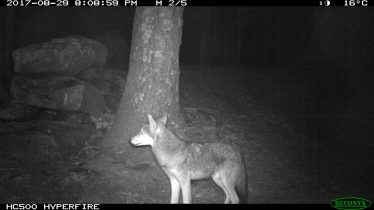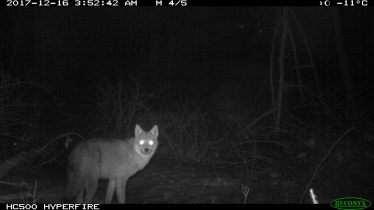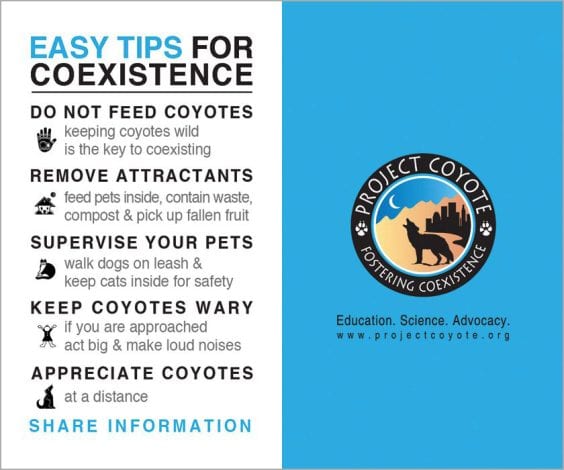Coexisting with Coyotes
What do bees, deer, and dogs have in common?
Statistically, these three creatures are more likely to seriously hurt you than a coyote — and even then, those chances are rather low. Yet a perfunctory search through local, regional, and national news outlets often yields alarmist reporting that convinces us that coyotes are on the prowl and it’s only a matter of time before our kids and pets end up becoming a tasty snack for them.
What gives? Deep down, I would guess most of us sense that there is a skewed perception of the danger, but perhaps we don’t “have all the facts” to back up that intuition. Luckily for you, we have many local experts who can help us understand key info that can keep us, our pets, and coyotes themselves safe from encounters with humans. To clarify, by “encounter,” I don’t mean a sighting: seeing an animal is usually accidental, especially on their part. Rather, by “encounter,” I am referring to an interaction in which you must make a decision about how to act in order to stay safe.
The key message communicated by all experts I consulted: the vast majority of potentially dangerous encounters are caused by people, and therefore, are also preventable by us! So, let’s dig in — helpful resources are listed at the end of the blog.
 What attracts coyotes to urban and suburban areas?
What attracts coyotes to urban and suburban areas?
Interestingly, in New York State, coyotes have been around for less than a century. The shift in their range to this area was facilitated by…you guessed it, humans! And guess what else? They remain successful in our urban and suburban areas mainly because of us. We pave the way, often literally, and their smarts do the rest. Our generally poor waste management (i.e., stinky, unsorted trash) and selective feeding of wild animals (such as feeding feral cats, deer, and even birds) creates Problem #1: the attraction of creatures that coyotes naturally feed on, mostly small mammals such as squirrels, chipmunks, and mice. So, the coyotes stick around for the easy food. Wouldn’t you?
It’s important to note that in New York State, it is illegal to feed wildlife such as deer. Feeding birds is not illegal; however, poorly managed bird feeders can still attract non-bird visitors, and therefore can also contribute to Problem #1.
Licensed wildlife rehabilitator and Vice President of the NY State Wildlife Rehabilitation Council, Maggie Ciarcia, also noted that letting pets such as cats and small dogs run around off-leash or unsupervised in a yard can also invite trouble, because to a coyote, they are simply another tasty small mammal.
How can I reduce the chances of a coyote encounter on my property and neighborhood?
Coyotes are canines, and like our family dogs, they can be trained with patience and consistency. If coyotes are sighted regularly in your area, hazing them with loud noises and intimidating body language such as making yourself appear larger by waving your arms can be helpful for maintaining a coyote’s natural fear of humans, especially if it is reinforced by others in your neighborhood. This only works if your community has made progress in first eliminating Problem #1, the easy food sources.
The stink often associated with trash mostly comes from food scraps being mixed in, and to a lesser extent from dirty recyclables. If you are looking to make your home coyote unfriendly, separating food scraps for composting and rinsing out recyclables are the nearly-perfect ways to eliminate Problem #1. A well-managed home compost system, whether indoors or out, will not smell nor attract unwanted wildlife. However, if you are not ready, willing, or able to commit that far, you’re in luck! Many communities in Westchester and beyond have or are in the process of adopting food scrap recycling drop-off sites, so you don’t have to worry about smells in your trash ever again. Composting is immensely beneficial to our communities and the environment in so many ways, so overall, taking this step is a big win for all, not just coyotes.
A coyote is near me right now: What should I do?
First and foremost, do not create conflict where there is none; if the coyote is acting normally (i.e., wary/fearful) around people and pets, give it space and respect its right to be there and pass through. Do not aggravate the animal just because you saw it.
 If a coyote approaches you, Lisa Kelly, Teatown’s Animal Care Supervisor, again recommends that you make loud noises and make yourself appear larger by waving your arms to haze or scare the coyote away. Do not run — acting like prey will only teach the coyote that you are harmless and not to be feared.
If a coyote approaches you, Lisa Kelly, Teatown’s Animal Care Supervisor, again recommends that you make loud noises and make yourself appear larger by waving your arms to haze or scare the coyote away. Do not run — acting like prey will only teach the coyote that you are harmless and not to be feared.
If loud noises do not discourage the coyote, Lisa indicates that it might be time to contact local authorities through their non-emergency line, or the Department of Environmental Conservation (DEC) at 518-402-8883.
Another reason to call the authorities is if the coyote appears sick or injured. Maggie Ciarcia suggests contacting a local wildlife rehabilitator so they can help you assess the situation and escalate only if necessary. You can access the DEC’s database of licensed rehabilitators here and keep the number handy for a rehabber near you.
Both Maggie and Lisa report taking “coyote calls” for animals that aren’t even remotely similar to coyotes, and regularly receive multiple reports about the fake coyote decoys used by municipalities to deter geese. The more you know, the less fear will inform your actions and help save resources such as Lisa, Maggie, and the local authorities for situations that do warrant their attention.
People often lament the loss of creatures such as wolves and mountain lions, which leaves behind unbalanced ecosystems where prey creatures such as deer run amok and cause problems of their own. Yet, the fearful, ignorant attitudes being adopted towards coyotes are the exact same ones that led us to obliterate the majestic creatures whose losses we now regret. We currently have the opportunity to act differently, to choose intentional, informed coexistence with wildlife. So let’s take it!
More information below
COYOTES IN HUMAN ENVIRONMENTS:
PBS Overview Season 1, Episode 21 (9mins): What are Wild Coyotes Doing in the Big City?
Gotham Coyote – NYC based
Project Coyote – California-based
Project Coyote Assorted factsheets (English and Spanish) to help bring awareness to your community:
Do not Feed Wildlife – here’s why
Report Illegal Wildlife Feeding: Call NYSDEC 518-402-8883
Coyote conflicts: how to avoid
Clear example of how human behavior directly created a nuisance coyote
NY Department of Environmental Conservation Licensed Wildlife Rehabilitator searchable directory
COMPOSTING SOURCES
Nearby towns with existing food scrap recycling drop off sites:
Town of Ossining (includes Village of Ossining and parts of Briarcliff Manor)
Croton on Hudson – Piloting a food scrap collection program in January 2023! Help it succeed by participating!
Briarcliff Manor: No food scrap recycling currently in place, yard waste only is currently accepted for drop off. Great opportunity to advocate in your community and encourage the shift to composting food waste!
MAP: NY State Food scrap drop off locations
Cornell Cooperative Extension Home Composting Guide
Contact us if you want more info or resources, we have lots available!





Leave a Reply